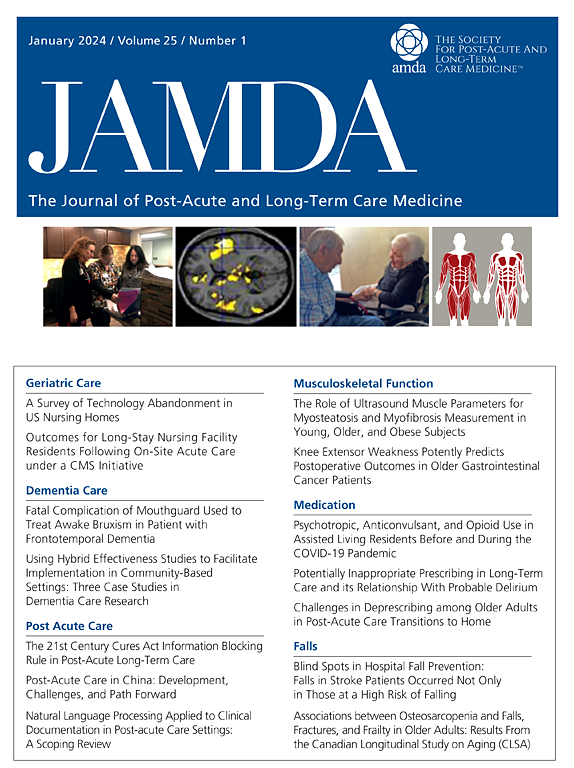A New Hospital-At-Home Model for Integrated Geriatric Care: Data from a Preliminary Italian Experience
IF 4.2
2区 医学
Q2 GERIATRICS & GERONTOLOGY
Journal of the American Medical Directors Association
Pub Date : 2024-10-05
DOI:10.1016/j.jamda.2024.105295
引用次数: 0
Abstract
Objective
Hospital-at-home (HaH) has emerged as an alternative to conventional in-hospital care in older adults, possibly reducing hospital admissions and related complications. This study aimed to describe the characteristics and outcomes of patients referred to “Gruppo di Intervento Rapido Ospedale-Territorio” (GIROT), a HaH service based on comprehensive geriatric assessment, developed in Florence, Italy, during the postpandemic period.
Design
Retrospective longitudinal study.
Setting and Participants
GIROT provided home-based care to patients with acute or exacerbated chronic diseases and a high risk of hospital-related complications (ie, patients with moderate-to-severe disability and/or dementia), referred from primary care, emergency departments, or in-hospital units.
Methods
All-cause mortality and hospitalization rates were assessed at 1, 3, and 6 months, and predictors of 6-month mortality were investigated.
Results
Among 391 patients (mean age, 88.4 years; 62.4% female) referred from emergency departments (58.6%), primary care (27.9%), and acute medical units (13.6%), the main diagnoses were respiratory failure (28.4%), acute heart failure (25.3%), and delirium (13.6%). Patients referred from primary care were older and showed a higher prevalence of severe disability and hypomobility. After 1, 3, and 6 months, mortality rates were 34.5%, 45.6%, and 53.8%, and hospitalization rates 7.2%, 21.5%, and 37.9%, respectively. Predictors of 6-month mortality included age [odds ratio (OR), 1.039], severe disability (OR, 3.446), impossible/assisted walking (OR, 4.450) and referral from primary care (OR, 2.066). High global satisfaction with the service was reported.
Conclusions and Implications
The GIROT model may help expanding acute health care capacity for older adults at high risk of hospital-related complications. Customized care plans are needed in patients with severe disability/hypomobility, considering also simultaneous palliative care.
医院到家庭的老年综合护理新模式:来自意大利初步经验的数据。
目的:作为老年人传统住院治疗的替代方案,"居家医院"(Hospital-at-home,简称 "HaH")的出现可能会减少老年人住院及相关并发症的发生。这项研究旨在描述 "Gruppo di Intervento Rapido Ospedale-Territorio"(GIROT)转诊患者的特征和治疗效果:设计:回顾性纵向研究:GIROT为患有急性病或慢性病加重、住院相关并发症风险较高的患者(即中度至重度残疾和/或痴呆患者)提供家庭护理,这些患者由初级保健、急诊科或住院部转介:方法:评估1、3和6个月的全因死亡率和住院率,并调查6个月死亡率的预测因素:在由急诊科(58.6%)、初级保健科(27.9%)和急诊科(13.6%)转诊的 391 名患者(平均年龄 88.4 岁;62.4% 为女性)中,主要诊断为呼吸衰竭(28.4%)、急性心力衰竭(25.3%)和谵妄(13.6%)。从基层医疗机构转来的患者年龄较大,严重残疾和活动能力低下的比例较高。1、3和6个月后,死亡率分别为34.5%、45.6%和53.8%,住院率分别为7.2%、21.5%和37.9%。6 个月死亡率的预测因素包括年龄(几率比 [OR],1.039)、严重残疾(OR,3.446)、无法/辅助行走(OR,4.450)和从初级保健转诊(OR,2.066)。对服务的总体满意度较高:GIROT 模式可能有助于扩大急症医疗服务能力,以应对老年人住院相关并发症的高风险。严重残疾/行动不便的患者需要定制护理计划,并同时考虑姑息治疗。
本文章由计算机程序翻译,如有差异,请以英文原文为准。
求助全文
约1分钟内获得全文
求助全文
来源期刊
CiteScore
11.10
自引率
6.60%
发文量
472
审稿时长
44 days
期刊介绍:
JAMDA, the official journal of AMDA - The Society for Post-Acute and Long-Term Care Medicine, is a leading peer-reviewed publication that offers practical information and research geared towards healthcare professionals in the post-acute and long-term care fields. It is also a valuable resource for policy-makers, organizational leaders, educators, and advocates.
The journal provides essential information for various healthcare professionals such as medical directors, attending physicians, nurses, consultant pharmacists, geriatric psychiatrists, nurse practitioners, physician assistants, physical and occupational therapists, social workers, and others involved in providing, overseeing, and promoting quality

 求助内容:
求助内容: 应助结果提醒方式:
应助结果提醒方式:


